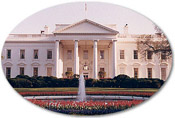

Who is the Vice President?
Vice President of the United States is only a heartbeat away from the most powerful elective office in the world. The Vice President must be ready to become President or acting President at a moment's notice if the President dies, resigns, is removed from office, or becomes unable to perform the duties of office.
Fourteen Vice Presidents have become President, eight because of the death of a President. These eight so-called “accidental Presidents” were John Tyler, Millard Fillmore, Andrew Johnson, Chester A. Arthur, Theodore Roosevelt, Calvin Coolidge, Harry S. Truman, and Lyndon B. Johnson. The other Vice Presidents who became President were John Adams, Thomas Jefferson, Martin Van Buren, Richard M. Nixon, Gerald R. Ford, and George Bush. Of these six, all but Nixon became President immediately after serving as Vice President. Ford was the only Vice President to take office because of a President's resignation.
The United States Constitution also provides that the Vice President shall become acting President if the President is disabled. In 1967, the 25th Amendment to the Constitution was ratified. It spelled out procedures in case of presidential disability and provided for vice presidential succession. Presidents James A. Garfield, Woodrow Wilson, and Dwight D. Eisenhower all had serious illnesses. But their Vice Presidents carefully avoided assuming the duties of the President. In 1985, George Bush became the first Vice President to serve as acting President. He held the office for about eight hours. President Ronald Reagan had designated Bush as acting President when Reagan had surgery.
The Vice President serves as the presiding officer of the United States Senate and has the title of president of the Senate. The Constitution gives the Vice President no other official duty. For more than 100 years, the job's lack of political importance caused it to be treated as somewhat of a joke. Some people had humorously suggested that the Vice President be addressed as “Your Superfluous Excellency.”
Yet the Founding Fathers had high hopes for the office of the vice presidency. James Iredell of North Carolina, who later served on the Supreme Court of the United States, explained that there would be “two men…in office at the same time; the President, who will possess, in the highest degree, the confidence of the country, and the Vice President, who is thought to be the next person in the Union most fit to perform this trust.”
The prestige of the vice presidency has gradually increased since the early 1920's. Beginning in 1933 with the presidency of Franklin D. Roosevelt, Vice Presidents have regularly attended meetings of the President’s Cabinet. Dwight D. Eisenhower and John F. Kennedy did more than any other Presidents to establish the importance of the office of Vice President. Eisenhower's Vice President, Richard M. Nixon, and Kennedy's Vice President, Lyndon B. Johnson, had important duties and responsibilities. When Kennedy was assassinated in 1963, many experts believed that Johnson was the best-prepared “accidental President.”
The Vice President has offices in the Capitol, the Richard B. Russell Office Building of the U.S. Senate, and the Executive Office Building. All these offices are in Washington, D.C. In 1974, Congress established a 33-room mansion on the grounds of Washington's Naval Observatory as the Vice President's official residence. Secret Service agents guard the Vice President.







